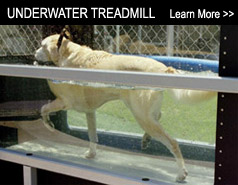 |
Frequently |
Q If my dog needs surgery, when should therapy begin?
A We are seeing clients for electric stimulation, range of motion/stretching and massage the same day or the day after surgery as the attending veterinarian requests (onsite at the surgery center). Progression of each client is a very individual situation and the veterinarian will tell us how to proceed.
Q How often do I need my dog to be seen and for how long?
A It depends on the individual dog and diagnosis. For many orthopedic conditions two to three times a week is ideal to begin. Therapy usually begins with modalities and exercise offered at local vet offices. One to two times per week following the initial therapy sessions and to maintain sufficient conditioning is normal. This is best discussed with the owner depending on the dogs condition and diagnosis.
Q Can I be with my dog during the session?
A Yes we encourage owner interaction and find it very beneficial for the dog and the owner.
Q My dog has had a stroke and can't move one/two or all four legs, can you help?
A We see excellent results with dogs following strokes and most of them return to walking/ running/playing at the park. Early sessions with electrical stimulation give a great deal of feedback to the brain and exercise the muscle while it doesn't get the signal from the brain on its own. ROM and stretching are very beneficial. A majority of our stroke dogs are back on their feet (at least somewhat) within 3-6 weeks. Swimming is perfect for these dogs; even when they are totally paralyzed on land. As soon as we get them into the water they usually start paddling!
Q My dog has degenerative myelopathy, can you help?
A Yes, we have seen progress with dogs with this diagnosis. We have seen return of muscle mass and improved stabilization and quality of gait. This depends on where the dog is in the progression of the disease and when they are able to begin rehab. We are not able to stop the disease itself but can offer a better quality of life for an extended period of time. Carts can be of help with keeping them mobile---they CAN use their legs in the carts we use---see links page for Doggon Wheels!
Copyright 2008 | Cutting Edge K-9 | San Diego, California | Phone (619) 227-7802 | Fax (619) 223-0400

